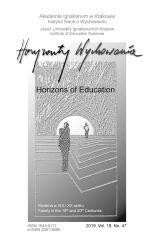Współczesny obraz nauczyciela w mediach społecznościowych na przykładzie serwisu YouTube – studium przypadku
Abstrakt
CEL NAUKOWY: Artykuł poświęcony jest kształtowaniu obrazu nauczyciela w serwisie YouTube, w materiałach kierowanych do nastolatków, na przykładzie kanału WAKSY. Przyjęta perspektywa badawcza skupia się nie na tym, jak szkoła może wykorzystać media, lecz jak media wykorzystują temat szkoły, by trafić do młodych odbiorców.
PROBLEM I METODY BADAWCZE: W artykule poddano jakościowej analizie treści wszystkie filmy opublikowane na kanale WAKSY. Badanie pozwoliło na wykazanie zasadniczych stereotypów dotyczących nauczycieli. Wyniki analizy zostały skonfrontowane z komentarzami użytkowników serwisu.
PROCES WYWODU: Niniejsze opracowanie zwraca uwagę na wszechobecność mediów w świecie współczesnych nastolatków. Serwisy społecznościowe, wykorzystywane dzisiaj jako źródło wiedzy o świecie, stanowią źródło postaw oraz tłumaczą zjawiska z życia społecznego. Mogą one, nawet w sposób dla odbiorcy nieuświadomiony, kształtować wizję otaczającego świata.
WYNIKI ANALIZY NAUKOWEJ: Analiza naukowa wykazała siedem skrajnie negatywnych obrazów nauczyciela, które prezentowane są odbiorcom w materiałach filmowych na omawianym kanale. Dotyczą one kwestii bardzo ważnych w pracy dydaktycznej i wychowawczej, jednak wypaczają obraz nauczyciela i przedstawiają go jako wroga ucznia.
WNIOSKI, INNOWACJE, REKOMENDACJE: Komentarze użytkowników YouTube’a sugerują, że uczniowie doszukują się w swoich szkołach potwierdzenia wizji nauczycieli prezentowanej na kanale WAKSY. Źródłem negatywnych zachowań uczniów może być przyjęty z mediów społecznościowych obraz nauczyciela jako wroga. Dla lepszego poznania zjawiska rekomendowane są dalsze badania, obejmujące również inne kanały i filmy o tematyce szkolnej.
Bibliografia
Dziadzia, B. (2008). Wpływ mediów. Konteksty społeczno-edukacyjne. Kraków: Oficyna Wydawnicza Impuls.
Gerbner, G. (2003). Teoria kultywowania postaw George’a Gerbnera. W: E. Griffin (red.), Podstawy komunikacji społecznej. Gdańsk: Gdańskie Wydawnictwo Psychologiczne. 381-390.
Huk, T. (2011). Media w wychowaniu, dydaktyce oraz zarządzaniu informacją edukacyjną szkoły. Kraków: Oficyna Wydawnicza Impuls.
Kobyłecka, E. (2010). Kwalifikacje i kompetencje współczesnego nauczyciela-wychowawcy. W: I. Nowosad, I. Mortag, J. Ondráková (red.), Jakość życia i jakość szkoły: wprowadzenie w zagadnienia jakości i efektywności pracy szkoły. Zielona Góra: Oficyna Wydawnicza Uniwersytetu Zielonogórskiego. 105-120.
Kreft, J., Karwat, Z. (2017). The Opinion of Facebook Friends as the Most Reliable Recommendation of Products and Services in Poland. The Evolution of Purchase Pathways in Social Media. Handel Wewnętrzny 63(5), 250-260.
Kwieciński, Z. (1998). Zmienić kształcenie nauczycieli. W: A. Siemak-Tylikowska, H. Kwiatkowska, S.M. Kwiatkowski (red.), Edukacja nauczycielska w perspektywie wymagań zmieniającego się świata. Warszawa: Żak.
Laskowska, M. (2012). Oddziaływanie i wpływ mediów audiowizualnych. Zarys problematyki. Studia Ełckie. (14). 351-360.
Liberska, H. (2014). The Wellbeing of Children: Its Source and How It is Affected by a Sense of Exclusion and Acculturation. W: H. Liberska, M. Franicka (red.), Child of many worlds. Frankfurt am Main: Peter Lang Edition. 11-21.
Małek, M.K. (2012). Młodzieżowe media rozrywkowe antynomią wychowania. Kultura – Media – Teologia. 10(3). 32-45.
Marczuk, S. (2001). Orientacje wartościujące nauczycieli w III Rzeczypospolitej. Studium socjologii edukacji. Rzeszów: Wydaw. Wyższej Szkoły Pedagogicznej.
Nowak-Dziemianowicz, M. (2012). Edukacja i wychowanie w dyskursie nauki i codzienności. Kraków: Oficyna Wydawnicza Impuls.
Okulicz-Kozaryn, K. (2013). Klimat i kultura szkoły a zachowania problemowe uczniów. Studia Edukacyjne. (29). 81-100.
Opozda, D. (2010). Poczucie sensu życia wychowawcy jako problem pedagogiki egzystencji. W: K. Denek, A. Kamińska, W. Kojs, P. Oleśniewicz (red.), Edukacja jutra. Edukacja w społeczeństwie wiedzy, Sosnowiec: Oficyna Wydawnicza „Humanitas”.
Piechota, G. (2010). Szkoła w kryzysie versus media. Warszawa: ABC a Wolters Kluwer business.
Polak, K. (2007). Kultura szkoły: od relacji społecznych do języka uczniowskiego. Kraków: Wydawnictwo Uniwersytetu Jagiellońskiego.
Szews, P. (2014). Serwisy społecznościowe jako źródło informacji dziennikarskiej – problemy i zagrożenia. Kultura – Media – Teologia. 18(3), 90-104.
Sztompka, P. (2005). Socjologia wizualna: fotografia jako metoda badawcza, Warszawa: PWN.
Walotek-Ściańska, K., Szyszka, M. (2014). Pomiędzy integracją a dezintegracją komunikacji: socjolekt uczniów i studentów. W: K. Walotek-Ściańska, M. Szyszka (red.), Komunikowanie się ludzi młodych we współczesnym świecie. Bielsko-Biała: Wyższa Szkoła Administracji. 55-70.
Źródła internetowe
Cooper, P. (2018, 13 listopada). 41 Facebook Stats That Matter to Marketers in 2019. Pobrane z: https://blog.hootsuite.com/facebook-statistics/#usage
Drzewiecki, P. (2010). Media aktywni. Dlaczego i jak uczyć edukacji medialnej. Pobrane z: http://otworzksiazke.pl/images/ksiazki/media_aktywni/media_aktywni.pdf
Gottfried, J., Shearer, E. (2016, 26 maja) News Use Across Social Media Platforms 2016. Pobrane z: https://www.journalism.org/2016/05/26/news-use-across-social-media-platforms-2016/
Kruszewska, A. (2013). Mass media i edukacja. Aktuálne otázky prírodovedno-technických predmetova prierezových tém v primárnej edukácii. Online Konferencia 23. –25.10.2013. Pobrane z: http://www.pulib.sk/web/kniznica/elpub/dokument/Kancir1/subor
Michniuk, A. (2014). YouTube – YouLearn. Nauka przez YouTube?. E-mentor. (4). 37-43. DOI: 10.15219/em56.1122. Pobrane z: http://www.e-mentor.edu.pl/_pdf/56/Art_37-43_Michniuk_Em_4_56_pazdziernik_2014.pdf
Przewłocka, J. (2015). Klimat szkoły i jego znaczenie dla funkcjonowania uczniów w szkole. Raport o stanie badań. Warszawa: Instytut Badań Edukacyjnych. Pobrane z: http://produkty.ibe.edu.pl/docs/inne/ibe-analizy-08-2015-klimat-szkoly.pdf
Social Blade. (2019). Top 250 YouTubers in Poland sorted by SB Rank. Pobrane z: https://socialblade.com/youtube/top/country/pl
Social Blade. (2019). Top 250 YouTubers in Poland sorted by Subscribers. Pobrane z: https://socialblade.com/youtube/top/country/pl
YouTube (brak daty). YouTube w liczbach. Pobrane z:
Copyright (c) 2020 Barbara Cyrek

Utwór dostępny jest na licencji Creative Commons Uznanie autorstwa – Bez utworów zależnych 4.0 Międzynarodowe.
Uwagi dotyczące praw autorskich
Autorzy publikujący w tym czasopiśmie wyrażają zgodę na następując warunki:
- Autorzy zachowują prawa autorskie, przyznając czasopismu prawo do pierwszej publikacji swojego tekstu jednocześnie zarejestrowanego pod numerem licencji CC BY-ND, która pozwala innym na korzystanie z tego tekstu z uznaniem autorstwa tekstu oraz pierwotnej publikacji w tym czasopiśmie.
- Autorzy proszeni są o nawiązywanie odrębnych, dodatkowych porozumień wynikających z umowy, dotyczących dystrybucji opublikowanej w czasopiśmie wersji tekstu nie na prawach wyłączności (np. opublikowanie go w repozytorium instytucji lub w innym czasopiśmie), z potwierdzeniem pierwszej publikacji w tym czasopiśmie.
Wyraża się zgodę i zachęca autorów do publikacji ich tekstu w Internecie (np. w repozytorium instytucji lub na jej stronie internetowej) przed lub podczas procesu składania tekstu jako, że może to prowadzić do korzystnych wymian oraz wcześniejszego i większego cytowania opublikowanego tekstu (Patrz The Effect of Open Access). Zalecamy wykorzystanie dowolnego portalu stowarzyszeń badawczych z niżej wymienionych:





